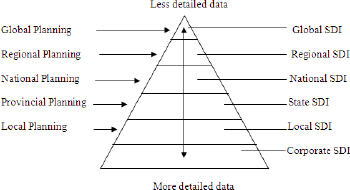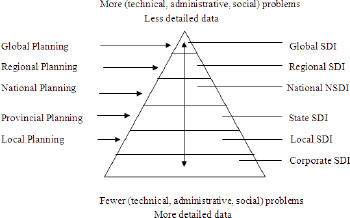A special characteristic of spatial data is that they can be shared and used for many purposes other than the one for which they were originally produced. To facilitate their efficient sharing and reuse, they need to be properly managed in the form of an infrastructure - an SDI - as discussed, for example, by Crompvoets (pdf). This is one of the reasons that many countries are developing SDIs. de Man (pdf) pointed out the challenge of developing an infrastructure that needs to be used for different purposes and at different administrative levels:
"Development, adoption, and application of any information infrastructure will be different at different spatial (or geographical) levels because of the different social contexts. Technical and bureaucratic issues and values seem to dominate data handling at higher levels, whereas social issues and human values play a pronounced role at local levels of human interaction. Information infrastructures encompassing different geographical and administrative levels may face the problem of having to deal with different and sometimes conflicting institutional arrangements in different social systems."During discussion on various levels of SDI development, Don Grant and Williamson (2004) also found, "This presents a whole range of issues and experiences concerned with interoperability, jurisdictional responsibility, privacy …" (p.112). Similarly, Pickels (2004) argued for the same thought: "SDIs are also susceptive to geopolitical, economic, and socio-cultural issues and all the associated opportunities and threats of cyber spaces and interactions." Therefore, SDIs and other kinds of information infrastructure alike are different at different spatial (or geographical) levels because of differentiated social contexts. (de Man 2006).
 |
It is clear from the above model developed by Rajabifard that a global SDI is based on a regional SDI, a regional SDI is based on a national SDI, and a national SDI is based on a state SDI and so on. But it does not reflect how the scale of problems would vary along this hierarchy. It is believed that moving "up" in the SDI hierarchy will bring more socio-technical problems. The model presented by Rajabifard does not speak of technical problems such as interoperability, administrative problems such as jurisdictional issues, and social problems such as privacy issues while moving along the hierarchy.
For example, problems at a state SDI level will be less than problems at national SDI. One reason is that upper-level SDIs inherit from lower-level SDIs. The second reason is there will be many state SDIs, which means many organizations will be involved, and in the case of more organizations, legal, technical and cultural problems will arise. Every state has its own norms, rules and regulations. One state may categorize a certain type of information as classified and may not permit everyone to access it, whereas another state may offer open access to the same information. For example, Goa is an Indian state. The editor of Coordinates in August 2007 envisioned, "Goa being a costal state falls under the secret category and its maps can not be put on a network." Similarly, moving from "more detailed data" to "less detailed data" will offer significant technical problems. For instance, in the case of coastal lines, the generalization rules adopted by different states may be different. Therefore, the gravity of the situation will become more problematic and increase when going up in SDI hierarchy, which is presented graphically in figure 2.
 |
At a higher administrative level, the need for small scale data arises but it poses more technical and administrative problems to spatial data managers. At the lower administrative level, the needed large scale data can be maintained with fewer technical, administrative and social problems, as is being done in Survey of Pakistan.